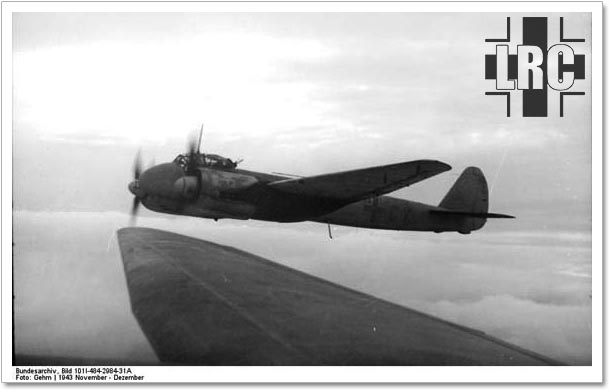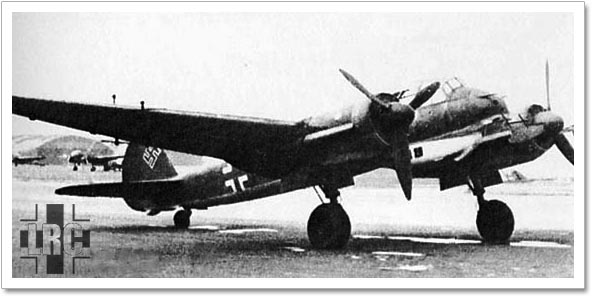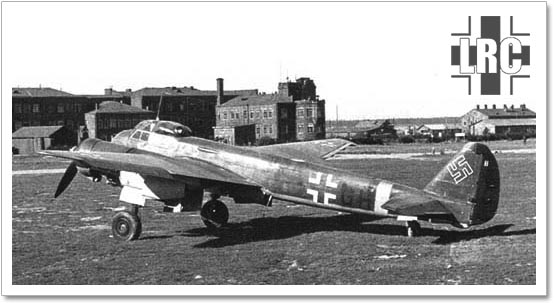Junkers Ju 88
Variants
Ju 88A Series
Main bomber type with Jumo 211 engines.
Junkers Ju 88A, 1940.
[Source: Bundesarchiv]
Ju 88A-0
Pre-production aircraft.Ju 88A-1
Initial production variant. 895 kW (1,200 hp) Jumo 211B-1 enginesJu 88A-2
Jumo 211 G-1 engines.Ju 88A-3
Conversion trainer. Dual controls.Ju 88A-4
Improved variant. Long span wings. Modified with new bomb dropping equipment to produce a A-15 "special" bomber variant. RLM refused to authorise mass production, as the wooden bomb bay "bulge" caused too much drag and a thus a reduction in speed.
Junkers Ju 88A-4 of LG1, Sicily, summer 1942.
[Source: Unknown]
Ju 88B Series
Prototype with all-new fully glazed "stepless" crew compartment nose, developed into Ju 188.Ju 88B-0
10 pre-production aircraft with "stepless" fully glazed nose.Ju 88C Series
The Ju 88C was originally intended as a fighter-bomber and heavy fighter by adding fixed, forward-firing guns to the nose while retaining some bomb carrying ability of the A-series bomber. The C-series had a solid metal nose, and retained the A-series style vertical tail, while omitting the ventral Bola gondola under the crew compartment. It was later used as a night fighter and this became the main role of the Ju 88C.
Junkers Ju 88C.
[Source: Bundesarchiv]
Ju 88C-1
Planned fighter variant, powered by two BMW 801MA engines. Never built.Ju 88C-2
Initial production variant.Ju 88C-4
Heavy fighter, reconnaissance variant.Ju 88C-5
Improved heavy fighter variant.Ju 88C-6a
Improved Ju 88C-5 variant.Ju 88C-6b
Night fighter variant.
Junkers Ju 88C-6b.
[Source: unknown]
Ju 88C-6c
Night fighter variant.Ju 88C-7a
Intruder variant.Ju 88C-7b
Intruder variant.Ju 88C-7c
Heavy fighter variant.Ju 88D Series
Long-range photo-reconnaissance variants, based on the Ju 88A-4.Ju 88D-1
Long-range photo-reconnaissance variant based on Ju 88A-4.
Junkers Ju 88D-1.
[Source: unknown]
Ju 88D-2
Long-range photo-reconnaissance variant based on Ju 88A-5.Ju 88D-3
Tropicalized long-range photo-reconnaissance variant based on Ju 88A-4.Ju 88D-4
Tropicalized long-range photo-reconnaissance variant based on Ju 88A-5.Ju 88D-5
Ju 88G Series
All previous night fighter versions of the Ju 88used a modified A-series fuselage. The G-series fuselage was purpose-built for the special needs of a night fighter, with the A-series' Bola ventral under-nose defensive gun position omitted for lower aerodynamic drag and less weight. G-1 aircraft were fitted with the enlarged squared-off vertical fin/rudder tail unit of the Ju 188, more powerful armament and 1,700 PS BMW 801 G-2 radial engines. Electronic equipment consisted of the then-standard FuG 220 Lichtenstein SN-2 90 MHz VHF radar plus sometimes additional FuG 350 Naxos or FuG 227 Flensburg homing devices. G-6 versions were equipped with 1,750 PS Jumo 213A inline-V12 engines, enlarged fuel tanks and often one or two 20 mm MG 151/20 cannons in a Schräge Musik ("Jazz Music", i.e. slanted) installation. Guns were firing obliquely upwards and forwards from the upper fuselage - usually at an angle of 70°. Some of the final G-series models received updates to the engine, a high-altitude Jumo 213E or to the radar, FuG 218 Neptun V/R or the even newer FuG 240 Berlin N-1 cavity magnetron based, 3 GHz-band (centimetric) radar. Only about 15 of those were completed before V-E Day. Many Luftwaffe night fighter aces, such as Helmut Lent (110 victories) and Heinrich von und zu Sayn-Wittgenstein (87 victories) flew Ju 88s during their careers. The Imperial Japanese Navy ordered the specifications of an anti-submarine patrol/escort fleet aircraft, based on a medium bomber. Kyu-shu- closely patterned the Kyu-shu- Q1W Tokai ("Eastern Sea", Allied codename "Lorna") antisubmarine patrol/fleet escort aircraft after the Ju 88.Ju 88H Series
Long-range photo-reconnaissance, fighter variants, based on the stretched Ju 88G-series fuselage.Ju 88H-1
Long-range photo reconnaissance variant.Ju 88H-2
Fighter variant.Ju 88H-3
Long-range photo-reconnaissance variant.Ju 88H-4
Fighters variant.Ju 88P Series
Anti-tank and anti-bomber variant with single Bordkanone series 50 mm (2 in), 75 mm (2.95 in) or twin 37 mm (1.46 in) calibre cannons in ventral fuselage gun pod mount, which mandated removal of the Bola gondola under the cockpit section, small series, conversion of A-series bomber.
Junkers JU 88P with twin 37mm BK 37 cannon.
[Source: unknown]
Ju 88P-1
Heavy-gun variant fitted with single 75 mm (2.95 in) Bordkanone BK 75 cannon in ventral gun pod.
Junkers JU 88P-1 with 75mm BK 75 cannon.
[Source: unknown]
Ju 88P-2
Heavy-gun variant with twin 37 mm (1.46 in) Bordkanone BK 37 cannon in ventral gun pod.Ju 88P-4
Heavy-gun variant with single 50 mm (2 in) Bordkanone BK 5 cannon in ventral gun pod.Ju 88R Series
The Ju 88R series night fighters were basically versions of the Ju 88C-6b powered by BMW 801 radial engines. The R-1 had 1,560 PS BMW 801L engines and the R-2 had 1,700 PS BMW 801 G-2 engines. One of the first aircraft from the R-1 series that went into service (Werknummer 360043) was involved in one of the most significant defections which the Luftwaffe suffered. On 9 May 1943, this night fighter, which was stationed with 10./NJG 3 in Norway, flew to the RAF Station at Dyce (now Aberdeen Airport) with its entire crew and complete electronic equipment on board. The fact that Spitfire fighters escorted it towards the end of its flight could indicate that its arrival had been expected. It was immediately transferred to Farnborough Airfield, received RAF markings and serial (PJ876), and was tested in great detail. The preserved aircraft is on exhibit at the RAF Museum. The Luftwaffe only learned of this defection the following month when members of the crew, pilot Oberleutnant Heinrich Schmitt and Oberfeldwebel Paul Rosenberger and Erich Kantwill, made broadcasts on British radio.Ju 88S Series
High-speed bomber series based on Ju 88A-4 but with ventral Bola gondola omitted, smoothly-glazed nose and GM-1 nitrous-oxide boost, fastest of all variants.Ju 88S-0
Fitted with two BMW 801 G-2 engines, single 13 mm (.51 in) dorsal gun and 14 SD65 (65 kg/143 lb) bombs.Ju 88S-1
Fitted with two BMW 801 G-2 engines, the GM-1 boost system and could carry two SD1000 1,000 kg (2,200 lb) bombs externally.Ju 88S-2
Fitted with two turbocharged BMW 801J engines, wooden bomb bay extension as used on the Ju 88A-15.Ju 88S-3
Fitted with two 1,671 kW (2,240 hp) Juma 213A engines and GM-1 boost system.Ju 88T Series
Three-seat photo-reconnaissance version of S-series.Ju 88T-1
Based on the Ju 88S-1 but with bomb bays fitted for extra fuel of GM-1 tanks.Ju 88T-3
Based on the Ju 88S-3.
Sources:
Gunston, Bill - The Encyclodepia of the Worlds Combat aircraft, 1976, Chartwell Books, Inc., New York
Brown, Eric, Captain - Wings of the Luftwaffe , 1979, Airlife Publishing Ltd., Shrewsbury
, 1979, Airlife Publishing Ltd., Shrewsbury
Gunston, Bill & Wood, Tony - Hitler's Luftwaffe , 1977, Salamander
Books Ltd., London
, 1977, Salamander
Books Ltd., London
Donald, David - The Complete Encyclopedia Of World Aircraft, 1997, Brown Packaging Books Ltd., London
Wikipedia - Junkers Ju 88
Gunston, Bill - The Encyclodepia of the Worlds Combat aircraft, 1976, Chartwell Books, Inc., New York
Brown, Eric, Captain - Wings of the Luftwaffe
Gunston, Bill & Wood, Tony - Hitler's Luftwaffe
Donald, David - The Complete Encyclopedia Of World Aircraft, 1997, Brown Packaging Books Ltd., London
Wikipedia - Junkers Ju 88






